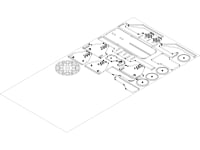The "Trekease" (Translational & Rotational Equivalent Kinetic Energy Aerobic Stationary Exertainment" is a device that enables a manual wheelchair user to propel themselves through virtual computer environments while remaining stationary. It has the capability to also provide rehab clinicians and wheelchair athletes information about distance traveled, maximum speed, power propulsion and caloric expenditure.
The trekease is designed to be assembled in about 10 minutes, with a precision interlocking frame cut on a CNC router and made with 1/2" cutting board plastic ( recycled HDPE or UHMW). Other components are made from recycled aluminum and stainless steel. The device is designed to not rust when exposed to moist environments and occupy a minimal footprint.
In addition to virtual wheelchair propulsion the device interfaces with handcycle and rowing attachments for a more complete workout.
A pair of quadrature encoders attached to the flywheel axles provide he sensors for data acquisition through a USB virtual joystick and/or proprietary hardware for enabling computer game, travel video and Avatar navigation while simultaneously providing quantitative dynamic information. Simple experimental calculations of coefficients of friction and flywheel moments of inertia make the Trekease into a clinical research and diagnostic tool.
The design has been refined over 3 years and now a 7th generation prototype. I am a paralyzed veteran who has used and manual wheelchair for 22 years have built this final production model out of my garage workshop with power hand tools with some parts made by local machine shops. UT senior student engineering students have assisted me in performing safety and reliability studies, stress analysis,CAD modeling, optimizing frame design, and development virtual navigation hardware and software strategies. A donated prototype to the San Antonio VA Spinal Cord Injury Clinic is currently being used as a research tool by a Stanford rehab physician at the Palo Alto VA for a wheelchair athlete study, another was given to the UT Austin Mechatronics program for future research, another will be provided to the OSU at Stillwater Wheelchair basketball team for research this spring, another to a disable children aerobic camp in Santa Cruz, California this fall, and another next year for a local Austin school's adaptive physical education program.
The tens of thousand of dollars for design and development and patenting of this device has been self funded since NO wheelchair manufacturer, exercise equipment manufacturer, or computer gaming manufacturer has shown any interest in participation. There were no SBIR grants that were suited for the development of this apparatus. The Trekease will be a sort of "Wii for Wheelchairs" that is unique in the world but through cost effective production could become common place as a source of exercise and entertainment "exertainment" for the 1.5 million manual wheelchair users in the US and the millions elsewhere in the world.
Voting
-
ABOUT THE ENTRANT
- Name:Christopher Stanford
- Type of entry:individual
- Profession:
- Number of times previously entering contest:never
- Christopher's favorite design and analysis tools:LabVIEW, TurboCAD,Rhinoceros,PunchPro,Inventor,Maple,SolidWorks
- For managing CAD data Christopher's company uses:None
- Christopher's hobbies and activities:Horticulture of Fruits and Nuts, Classical Guitar
- Christopher belongs to these online communities:youtube "trekease"
- Christopher is inspired by:Seeing a useful device developed that is simpler, less costly, safer and easier to use than what has been developed before by combining hand craftsmanship and technological innovation. Creating a useful apparatus that demonstrates simple principals of applied physics is especially fun for me.
- Hardware used for this entry:Carvewright CNC; Lowes, Harbor Freight, Grizzly and Home Depot power hand toolsSoftware used for this entry:Solid Works, Inventor, TurboCAD, Rhinoceros, LabVIEW, Maple
- Patent status:patented








